The Effect of Gravel and Sand Mining on Groundwater and Surface Water Regimes—A Case Study of the Velika Morava River, Serbia
Abstract
:1. Introduction
2. Study Area
3. Research Method
4. Results
5. Discussion
5.1. Analysis of the Surface Water Regime—The Velika Morava River
- —size of sample 1 (number of years),
- —size of sample 2 (number of years),
- —sample 1 average value,
- —sample 2 average value,
- —sample 1 standard deviation,
- —sample 2 standard deviation.
5.2. Analysis of the Groundwater Regime
6. Conclusions
Author Contributions
Funding
Data Availability Statement
Conflicts of Interest
References
- RZSS; Statistical office of the Republic of Serbia, Belgrade. Comparative Overview of the Number of Inhabitants 1948, 1953, 1961, 1971, 1981, 1991, 2002 and 2011; RZSS: Belgrade, Serbia, 2014. [Google Scholar]
- Urošev, M. Hydrological Droughts in the Velika Morava Basin. Ph.D. Thesis, Department of Geography, Tourism and Hotel Management, Faculty of Sciences, University of Novi Sad, Novi Sad, Serbia, 2016; pp. 1–159. [Google Scholar]
- Bjelajac, Ž.; Dukić-Mijatović, M.; Počuča, M. Dunav-reka saradnje i afirmacije bezbednosti, zaštite životne sredine i privrednog razvoja”, The 21st International Scientific Conference “Danube—River of Cooperation” The Role of Civil Society in Promotion of the Danube Basin Potential in the Light of the EU Strategy for Danube Region. In Institute of International Politics and Economics International Scientific Forum “Danube—River of Cooperation”, Belgrade, Serbia; Institute of International Politics and Economics and International Scientific FOrmu “Danube—River of Cooperation”: Belgrade, Serbia, 2011; pp. 43–55. ISBN 978-86-7067-161-4. [Google Scholar]
- Simić, V.; Bănăduc, D.; Curtean-Bănăduc, A.; Petrović, A.; Veličković, T.; Stojković-Piperac, M.; Simić, S. Assessment of the ecological sustainability of river basins based on the modified the ESHIPPOfish model on the example of the Velika Morava basin (Serbia, Central Balkans). Front. Environ. Sci. 2022, 10, 952692. [Google Scholar] [CrossRef]
- Government of the Republic of Serbia. Report on the Natural Disaster—Floods that Struck the Republic of Serbia and Measures Taken to Rescue the Population and Defend Endangered Areas from Floods; Government of the Republic of Serbia: Belgrade, Serbia, 2014.
- Macháček, J. Typology of Environmental Impacts of Artisinal and Small-Scale Mining in African Great Lakes Region. Sustainability 2019, 11, 3027. [Google Scholar] [CrossRef] [Green Version]
- Hilson, G.M. The Future of Small-scale mining: Environmental and socioeconomic perspectives. Futures 2002, 34, 863–872. [Google Scholar] [CrossRef]
- Hilson, G. The Socio-Economic Impacts of Artisanal and Small-Scale Mining in Developing Countries, 1st ed.; Taylor & Francis: London, UK, 2003; ISBN 1135291225. [Google Scholar]
- Byizigiro, R.V.; Raab, T.; Maurer, T. Small-scale opencast mining: An important research field for anthropogenic geomorphology. Die Erde 2015, 146, 213–231.49. [Google Scholar]
- Jones, D.K.C. The Evolution of Hillslope Processes. In Geomorphological Processes and Landscape Change; Blackwell Publishers Ltd.: Oxford, UK, 2001; pp. 61–89. [Google Scholar]
- Kihampa, C.; Wenaty, A. Impact of Mining and Farming activities on Water and Sediment Quality of the Mara river basin, Tanzania. Res. J. Chem. Sci. 2013, 3, 15–24. [Google Scholar]
- Nelson, A.D.; Church, M. Placer mining along the Fraser River, British Columbia: The geomorphic impact. Geol. Soc. Am. Bull. 2012, 124, 1212–1228. [Google Scholar] [CrossRef] [Green Version]
- Piyadasa, R.U.K. Sediment Problems and Sediment Management in Asian River Basins, Proceedings of the Workshop Held at Hyderabad, India; IAHS Publication: Wallingford, UK, 2009; Volume 349. [Google Scholar]
- Pitchaiah, P.S. Impacts of Sand Mining on Environment—A Review. Int. J. Geo Inform. Geol. Sci. 2017, 4, 2393–9206. [Google Scholar]
- Amponsah-Dacosta, F.; Mathada, H. Study of Sand Mining and Related Environmental Problems along the Nzhelele River in Limpopo Province of South Africa. In Mine Water and Circular Economy; Wolkersdorfer, C., Sartz, L., Sillanpää, M., Häkkinen, A., Eds.; IMWA: Lakewood, CO, USA, 2017; pp. 1259–1266. [Google Scholar]
- Liu, J.; Cao, G.; Zheng, C. Sustainability of Groundwater Resources in the North China Plain. In Sustaining Groundwater Resources; Jones, J.A.A., Ed.; Springer: Berlin/Heidelberg, Germany, 2011. [Google Scholar] [CrossRef]
- Zhang, Y.; Zhou, A.; Zhou, J.; Liu, C.; Cai, H.; Liu, Y.; Xu, W. Evaluating the Sources and Fate of Nitrate in the Alluvial Aquifers in the Shijiazhuang Rural and Suburban Area, China: Hydrochemical and Multi-Isotopic Approaches. Water 2015, 7, 1515–1537. [Google Scholar] [CrossRef] [Green Version]
- Brunner, P.; Cook, P.G.; Simmons, C.T. Disconnected surface water and groundwater: From theory to practice. Ground Water 2011, 49, 460–467. [Google Scholar] [CrossRef] [Green Version]
- Frei, S.; Fleckenstein, J.H.; Kollet, S.; Maxwell, R.M. Patterns and dynamics of river–aquifer exchange with variably-saturated flow using a fully-coupled model. J. Hydrol. 2009, 375, 383–393. [Google Scholar] [CrossRef]
- Kotowski, T.; Najman, J.; Nowobilska-Luberda, A.; Bergel, T.; Kaczor, G. Analysis of the interaction between surface water and groundwater using gaseous tracers in a dynamic test at a riverbank filtration intake. Hydrol. Process. 2023, 37, e14862. [Google Scholar] [CrossRef]
- Saravanan, S.P.; Desmet, M.; Neelakanta Pillai Kanniperumal, A.; Ramasamy, S.; Shumskikh, N.; Grosbois, C. Geochemical Footprint of Megacities on River Sediments: A Case Study of the Fourth Most Populous Area in India, Chennai. Minerals 2019, 9, 688. [Google Scholar] [CrossRef] [Green Version]
- Aguilar Pesantes, A.; Peña Carpio, E.; Vitvar, T.; María Mahamud López, M.; Menéndez-Aguado, J.M. A Multi-Index Analysis Approach to Heavy Metal Pollution Assessment in River Sediments in the Ponce Enríquez Area, Ecuador. Water 2019, 11, 590. [Google Scholar] [CrossRef] [Green Version]
- Čmelík, J.; Brovdyová, T.; Trögl, J.; Neruda, M.; Kadlečík, M.; Pacina, J.; Popelka, J.; Sirotkin, A.S. Changes in the Content of Heavy Metals in Bílina River during 2012–2017: Effects of Flood and Industrial Inputs. Water 2019, 11, 481. [Google Scholar] [CrossRef] [Green Version]
- Wrzesiński, D.; Sobkowiak, L. Transformation of the Flow Regime of a Large Allochthonous River in Central Europe—An Example of the Vistula River in Poland. Water 2020, 12, 507. [Google Scholar] [CrossRef] [Green Version]
- Abebe, W.B.; Tilahun, S.A.; Moges, M.M.; Wondie, A.; Derseh, M.G.; Nigatu, T.A.; Mhiret, D.A.; Steenhuis, T.S.; Camp, M.V.; Walraevens, K.; et al. Hydrological Foundation as a Basis for a Holistic Environmental Flow Assessment of Tropical Highland Rivers in Ethiopia. Water 2020, 12, 547. [Google Scholar] [CrossRef] [Green Version]
- Rempel, L.L.; Church, M. Physical and ecological response to disturbance by gravel mining in a large alluvial river. Can. J. Fish. Aquat. Sci. 2009, 66, 52–71. [Google Scholar] [CrossRef]
- Zhang, J.; Huang, T.; Chen, L.; Liu, X.; Zhu, L.; Feng, L.; Yang, Y. Water-Exchange Response of Downstream River–Lake System to the Flow Regulation of the Three Gorges Reservoir, China. Water 2019, 11, 2394. [Google Scholar] [CrossRef] [Green Version]
- Wang, W.; Oswald, S.E.; Gräff, T.; Lensing, H.J.; Liu, T.; Strasser, D.; Munz, M. Impact of river reconstruction on groundwater flow during bank filtration assessed by transient three-dimensional modelling of flow and heat transport. Hydrogeol. J. 2019, 28, 723–743. [Google Scholar] [CrossRef] [Green Version]
- Braud, I.; Breil, P.; Thollet, F.; Lagouy, M.; Branger, F.; Jacqueminet, C.; Kermadi, S.; Michel, K. Evidence of the impact of urbanization on the hydrological regime of a medium-sized periurban catchment in France. J. Hydrol. 2013, 485, 5–23. [Google Scholar] [CrossRef] [Green Version]
- Wang, Z.; Zhang, H.; Garzanti, E.; Nie, J.; Peng, W.; Andò, S.; Hu, X.; Pan, B.; Pfaff, K. Evolution of the Upper Yellow River as Revealed by Changes in Heavy-Mineral and Geochemical (REE) Signatures of Fluvial Terraces (Lanzhou, China). Minerals 2019, 9, 603. [Google Scholar] [CrossRef] [Green Version]
- Llena, M.; Vericat, D.; Martínez-Casasnovas, J.A.; Smith, M. Geomorphic responses to multi-scale disturbances in a mountain river: A century of observations. Catena 2019, accepted. [Google Scholar]
- Zhu, G.F.; Su, Y.H.; Feng, Q. The hydrochemical characteristics and evolution of groundwater and surface water in the Heihe River Basin, northwest China. Hydrogeol. J. 2008, 16, 167–182. [Google Scholar] [CrossRef]
- Mrokowska, M.M.; Rowiński, P.M. Impact of Unsteady Flow Events on Bedload Transport: A Review of Laboratory Experiments. Water 2019, 11, 907. [Google Scholar] [CrossRef] [Green Version]
- Google Maps. Europe. 2023. Available online: https://www.google.com/maps/place/Great+Morava/@44.2043754,20.6671265,9z/data=!3m1!4b1!4m6!3m5!1s0x47508d41636cad5d:0x77e10775345770bc!8m2!3d44.2042121!4d21.1585618!16zL20vMDQzbTMz?hl=en (accessed on 13 March 2023).
- Ristić Vakanjac, V.; Nikolić, J.; Vakanjac, B.; Polomčić, D.; Bajić, D.; Čokorilo Ilić, M.; Kresojević, M. Surface water flow as impacted by sand and gravel mining: Case study of the Velika Morava River, Serbia. In Proceedings of the 7th International Symposium Mining and Environmental Protection, MEP 19, Vrdnik, Serbia, 15–28 September 2019; pp. 203–210. [Google Scholar]
- RHMZ. Republic Hydrometeorological Service of Serbia. 2023. Available online: https://www.hidmet.gov.rs/index_eng.php (accessed on 15 March 2023).
- Available online: Glen, S. “Correlation Coefficient: Simple Definition, Formula, Easy Steps” From StatisticsHowTo.com: Elementary Statistics for the rest of us! Available online: https://www.statisticshowto.com/probability-and-statistics/correlation-coefficient-formula/ (accessed on 10 July 2023).
- Stepanović, M.; Bajić., D.; Polomčić, D.; Avramović, A.; Mijatović, B. Kvalitativne Karakteristike Podzemnih Voda Izvorišta „Ključ“ u Požarevcu. In XVI Srpski Hidrogeološki Simpozijum sa Međunarodnim Učešćem; Univerzitet u Beogradu, Rudarsko-geološki fakultet: Beograd, Serbia, 2022; pp. 495–500. [Google Scholar]
- Popović, L.; Popović., Z.; Ristić Vakanjac, V.; Vakanjac, B.; Mandić, M. Trenutno stanje i moguće posledice nekontrolisane eksploatacije šljunka po životnu sredinu i vodosnabdevanje—Primer Velike Morave. In XV Srpski Hidrogeološki Simpozijum Sa Međunarodnim Učešćem; Univerzitet u Beogradu, Rudarsko-geološki fakultet: Beograd, Serbia, 2014; pp. 435–440. [Google Scholar]
- Marković, D. Tumač-a za Osnovnu Hidrogeološku Kartu Republike Srbije, List Požarevac 1:100,000; Geološki zavod Srbije: Beograd, Serbia, (revidovana verzija).
- Official Gazette of the Republic of Serbia. The Rulebook on the Establishment of the River Sediments Extraction Plan; Official Gazette of the Republic of Serbia: Belgrade, Serbia, 2021. [Google Scholar]

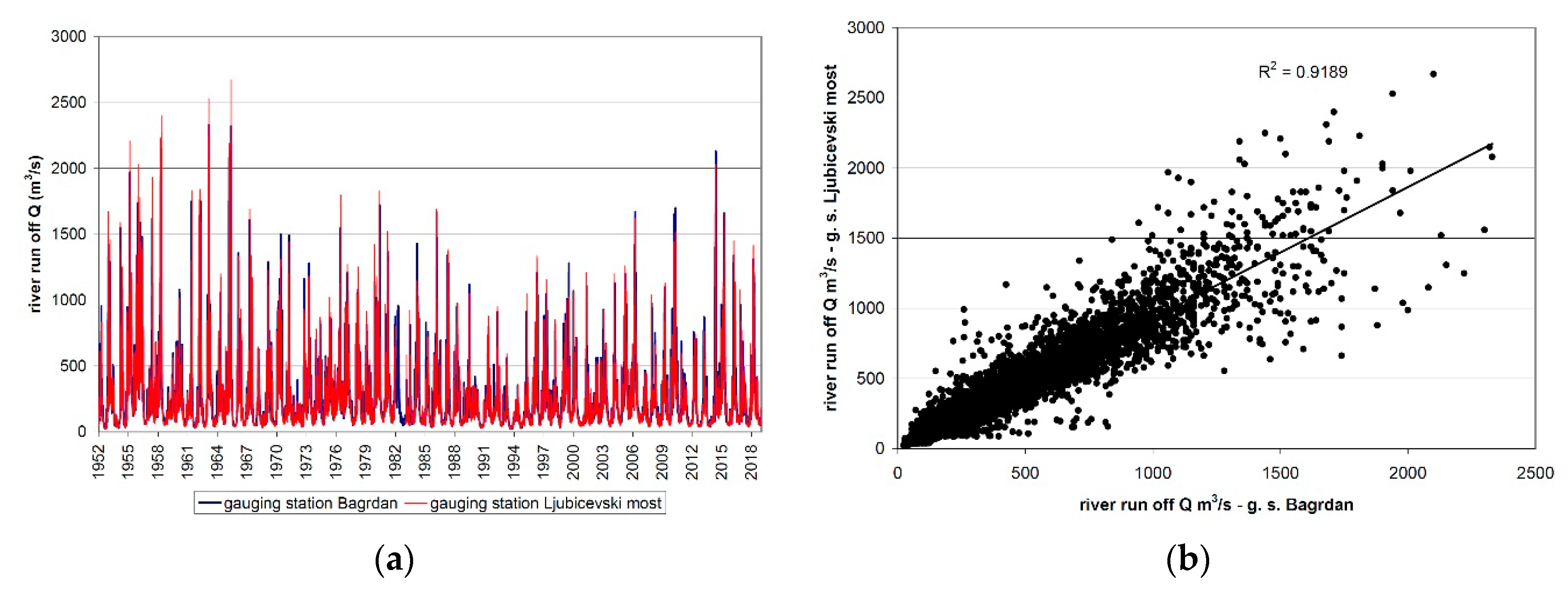



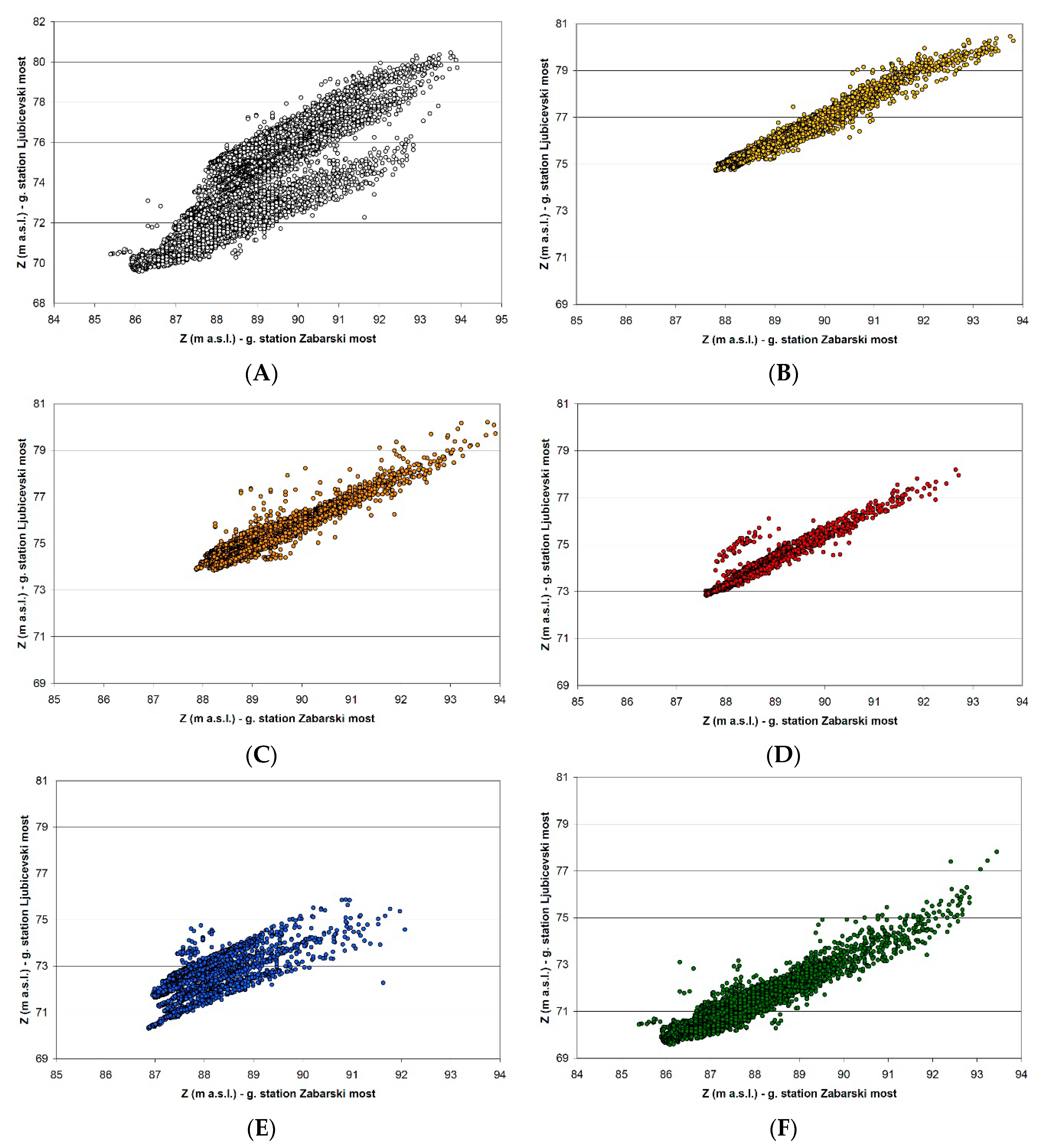

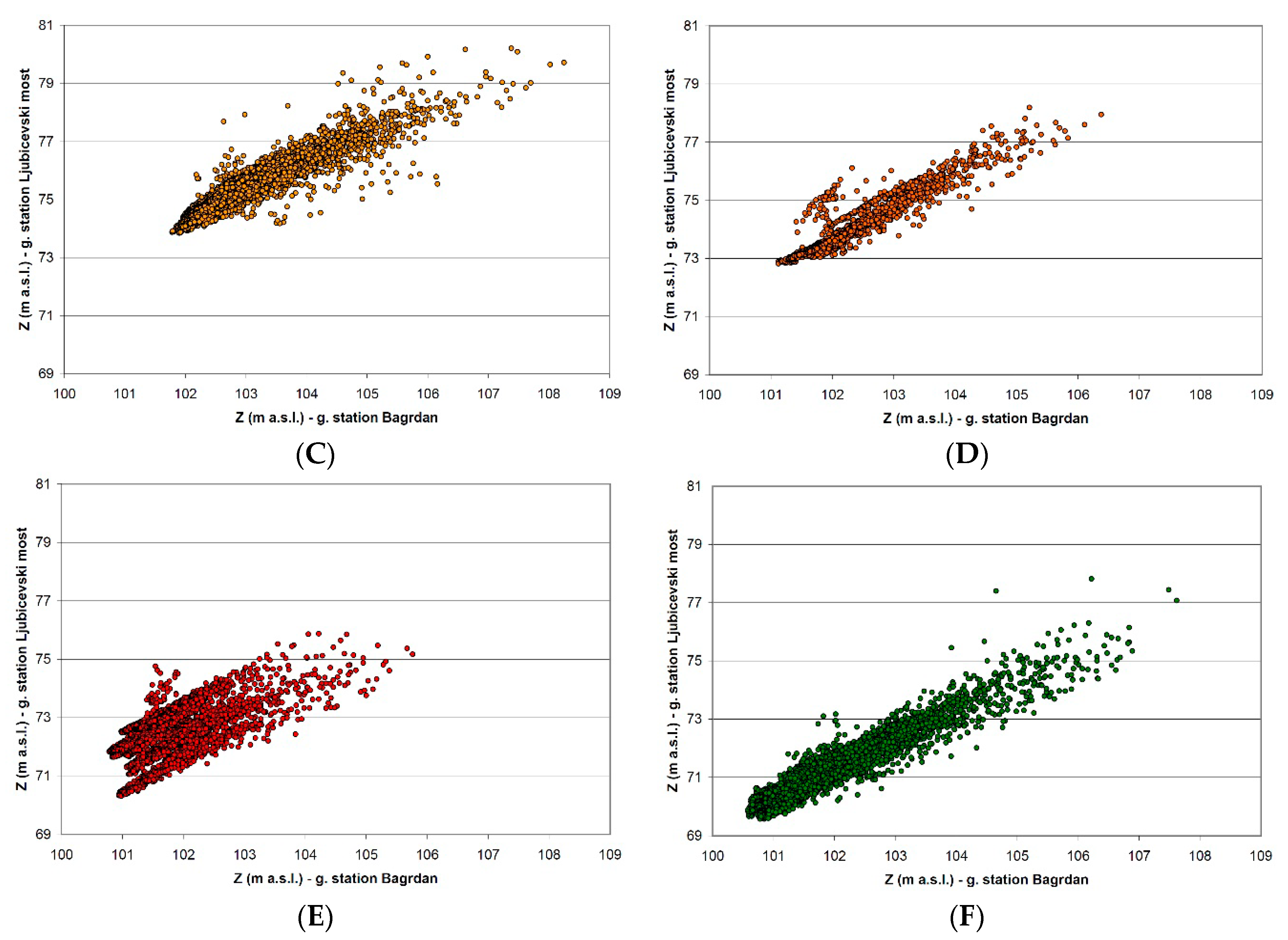
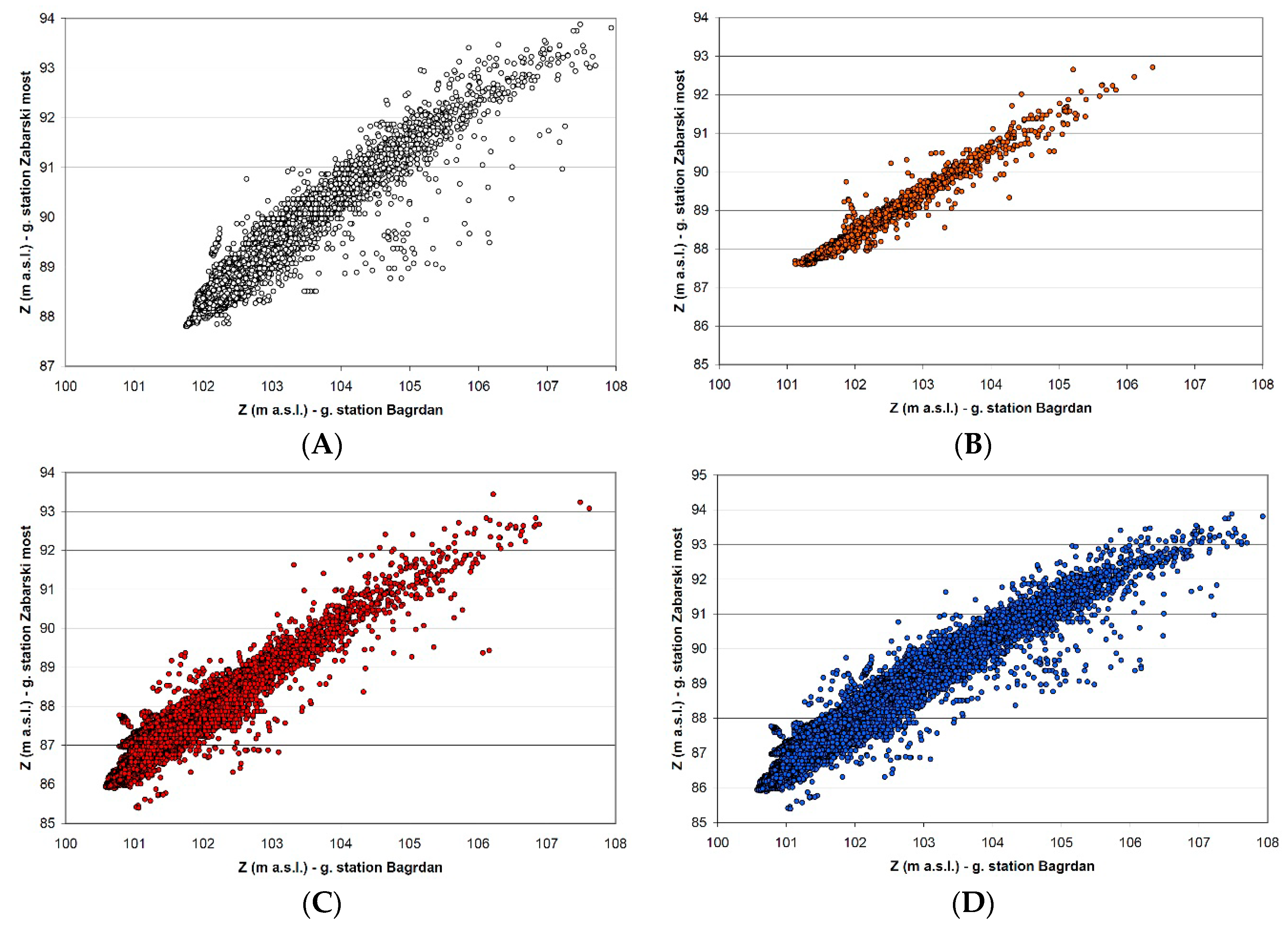


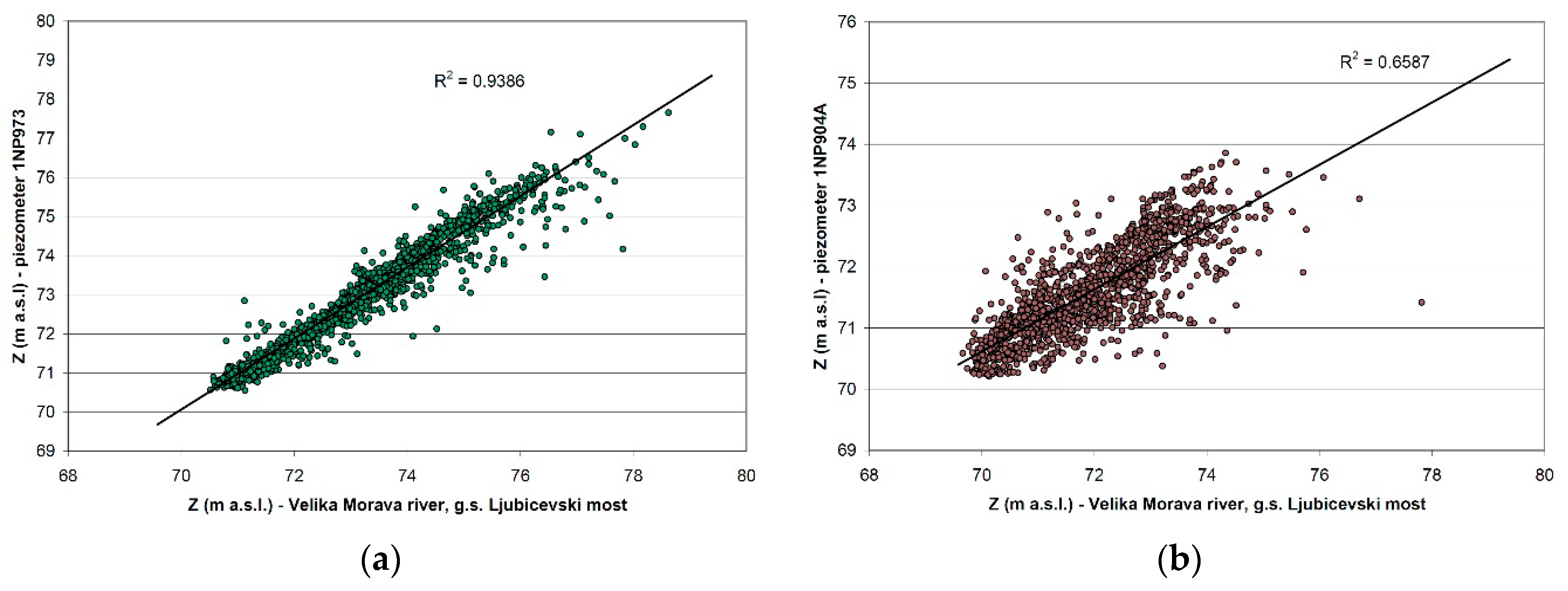
| Station | River | Year Established | “Zero” Altitude (m Adriatic Sea Level a.s.l.) | Distance from River Mouth (km) | Catchment Area (km2) | |
|---|---|---|---|---|---|---|
| 1 | Varvarin | Velika Morava | 1924 | 126.13 | 177.22 | 31,548 |
| 2 | Ćuprija | Velika Morava | 1923 | 112.49 | 145.41 | 32,561 |
| 3 | Bagrdan | Velika Morava | 1952 | 100.94 | 118.57 | 33,446 |
| 4 | Žabarski Most | Velika Morava | 1935 | 87.37 | 72.15 | 35,496 |
| 5 | Ljubičevski Most | Velika Morava | 1923 | 73.42 | 21.75 | 37,320 |
| Observation Well | Date Established | Distance from River (km) | x Coordinate | y Coordinate | “Zero” Altitude (m a.s.l.) | Depth (m) | |
|---|---|---|---|---|---|---|---|
| 1 | 1NP904A | 1 April 1988 | 0.91 | 4936914 | 7509794 | 79.81 | 16 |
| 2 | 1NP974 | 1 August 1977 | 1.54 | 4934636 | 7506681 | 78.72 | 9.2 |
| 3 | 1NP901A | 1 July 1987 | 0.2 * | 4933941 | 7505427 | 78.37 | 14.1 |
| 4 | 1NP966 | 1 October 1977 | 0.09 | 4944990 | 7505988 | 75.31 | 11.5 |
| 5 | 1NP973 | 1 January 1978 | 0.03 | 4937900 | 7510950 | 80.45 | 9.2 |
| 6 | 1NP908A | 1 July 1987 | 1.16 | 4938752 | 7511669 | 78.18 | 13.73 |
| 7 | 1NP909A | 1 July 1987 | 2.01 | 4939200 | 7512475 | 78.06 | 11.05 |
| 8 | 1NP910A | 1 July 1987 | 2.83 | 4939725 | 7513050 | 77.75 | 11.21 |
| 9 | 1NPP-1 | 1 April 2002 | 6.42 | 4943425 | 7513625 | 78.8 | 21 |
| 10 | 1NP929A | 1 July 1987 | 1.71 | 4911009 | 7512157 | 93.26 | 12.3 |
| Ljubičevski Most—Žabarski Most | Correlation coefficient—r |
| 1952–1962 | 0.981 |
| 1963–1981 | 0.946 |
| 1982–1989 | 0.964 |
| 1990–1999 | 0.687 |
| 2000–2018 | 0.948 |
| total period | 0.865 |
| Ljubičevski Most—Bagrdan | Correlation coefficient—r |
| 1952–1962 | 0.963 |
| 1963–1981 | 0.941 |
| 1982–1989 | 0.946 |
| 1990–1999 | 0.599 |
| 2000–2018 | 0.955 |
| total period | 0.803 |
| Žabarski Most—Bagrdan | Correlation coefficient—r |
| 1952–1981 | 0.957 |
| 1981–1989 | 0.980 |
| 1990–2018 | 0.944 |
| total period | 0.960 |
| Period | Sample Size | Gauging Station Bagrdan | Gauging Station Žabarski Most | Gauging Station Ljubičevski Most |
|---|---|---|---|---|
| Average value | ||||
| I: 1952–1962 | 11 | 103.14 | 89.43 | 76.38 |
| II: 1963–1981 | 19 | 102.85 | 89.20 | 75.18 |
| III: 1982–1989 | 8 | 102.29 | 88.62 | 73.95 |
| IV: 1990–1999 | 10 | 101.83 | 87.99 | 72.52 |
| V: 2000–2018 | 19 | 101.81 | 87.58 | 71.10 |
| Standard deviation | ||||
| I: 1952–1962 | 11 | 0.88 | 0.99 | 1.00 |
| II: 1963–1981 | 19 | 0.80 | 0.87 | 0.85 |
| III: 1982–1989 | 8 | 0.71 | 0.77 | 0.82 |
| IV: 1990–1999 | 10 | 0.62 | 0.68 | 0.66 |
| V: 2000–2018 | 19 | 0.87 | 1.00 | 0.91 |
| Sample Homogeneity Test | Time-Series Homogeneity | |||
|---|---|---|---|---|
| Gauging station at Bagrdan | ||||
| I and II | −2.048 | 0.843 | 2.048 | yes |
| II and III | −2.06 | 1.671 | 2.06 | yes |
| III and IV | −2.12 | 1.378 | 2.12 | yes |
| IV and V | −2.025 | 0.063 | 2.025 | yes |
| Gauging station at Žabarski Most | ||||
| I and II | −2.048 | 0.615 | 2.048 | yes |
| II and III | −2.06 | 1.585 | 2.06 | yes |
| III and IV | −2.12 | 1.727 | 2.12 | yes |
| IV and V | −2.025 | 1.134 | 2.025 | yes |
| Gauging station at Ljubičevski Most | ||||
| I and II | −2.048 | 3.274 | 2.048 | no |
| II and III | −2.06 | 3.326 | 2.06 | no |
| III and IV | −2.12 | 3.880 | 2.12 | no |
| IV and V | −2.025 | 3.880 | 2.025 | no |
| Sample Homogeneity Test | Time-Series Homogeneity | |||
|---|---|---|---|---|
| Gauging station at Bagrdan | ||||
| I and II | 1.204 | 2.41 | < | yes |
| II and III | 1.270 | 3.44 | < | yes |
| III and IV | 1.326 | 3.14 | < | yes |
| IV and V | 1.957 | 2.46 | < | yes |
| Gauging station at Žabarski Most | ||||
| I and II | 1.307 | 2.41 | < | yes |
| II and III | 1.292 | 3.44 | < | yes |
| III and IV | 1.285 | 3.14 | < | yes |
| IV and V | 2.208 | 2.46 | < | yes |
| Gauging station at Ljubičevski Most | ||||
| I and II | 1.380 | 2.41 | < | yes |
| II and III | 1.091 | 3.44 | < | yes |
| III and IV | 1.540 | 3.14 | < | yes |
| IV and V | 1.901 | 2.46 | < | yes |
Disclaimer/Publisher’s Note: The statements, opinions and data contained in all publications are solely those of the individual author(s) and contributor(s) and not of MDPI and/or the editor(s). MDPI and/or the editor(s) disclaim responsibility for any injury to people or property resulting from any ideas, methods, instructions or products referred to in the content. |
© 2023 by the authors. Licensee MDPI, Basel, Switzerland. This article is an open access article distributed under the terms and conditions of the Creative Commons Attribution (CC BY) license (https://creativecommons.org/licenses/by/4.0/).
Share and Cite
Kresojević, M.; Ristić Vakanjac, V.; Trifković, D.; Nikolić, J.; Vakanjac, B.; Polomčić, D.; Bajić, D. The Effect of Gravel and Sand Mining on Groundwater and Surface Water Regimes—A Case Study of the Velika Morava River, Serbia. Water 2023, 15, 2654. https://doi.org/10.3390/w15142654
Kresojević M, Ristić Vakanjac V, Trifković D, Nikolić J, Vakanjac B, Polomčić D, Bajić D. The Effect of Gravel and Sand Mining on Groundwater and Surface Water Regimes—A Case Study of the Velika Morava River, Serbia. Water. 2023; 15(14):2654. https://doi.org/10.3390/w15142654
Chicago/Turabian StyleKresojević, Milan, Vesna Ristić Vakanjac, Dragan Trifković, Jugoslav Nikolić, Boris Vakanjac, Dušan Polomčić, and Dragoljub Bajić. 2023. "The Effect of Gravel and Sand Mining on Groundwater and Surface Water Regimes—A Case Study of the Velika Morava River, Serbia" Water 15, no. 14: 2654. https://doi.org/10.3390/w15142654
APA StyleKresojević, M., Ristić Vakanjac, V., Trifković, D., Nikolić, J., Vakanjac, B., Polomčić, D., & Bajić, D. (2023). The Effect of Gravel and Sand Mining on Groundwater and Surface Water Regimes—A Case Study of the Velika Morava River, Serbia. Water, 15(14), 2654. https://doi.org/10.3390/w15142654







